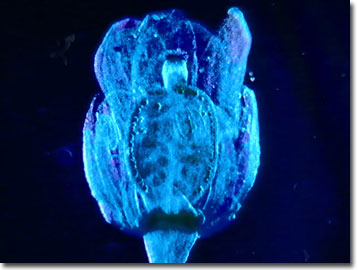Darkfield Digital Image Gallery
Shepherd's Purse (Capsella) Embryos
An annual herb of the mustard family (Cruciferae or Brassicaceae), the shepherd's purse (Capsella bursa-pastoris) is a native to the Mediterranean nations. This hardy botanical has accompanied Europeans in their migrations, and it is now found in most every part of the world.

View a second image of Shepherd's Purse (Capsella) Embryos.
The shepherd's purse has a slender stem, clusters of tiny white flowers, and triangular seedpods that resemble old-world leather purses, thus their common name. The herb bears flat, heart-shaped fruit pods, which, upon ripening, separate into two valves containing numerous yellow, oblong seeds. Capsella has a long history of medicinal applications and is believed to have diuretic and haemostyptic properties. A decoction yields a tannate and alkaloid called bursine.
Some botanists consider the shepherd's purse to be carnivorous. When moistened, the seeds of this plant release an adhesive compound that can trap small aquatic invertebrates and, after their death, the decomposing remains may serve as fertilizer for the germinating plant embryos. This phenomenon is so notable that some people have attempted mosquito control by scattering shepherd's purses over lake surfaces. However, the jury is still out on the true role of the seed mucous since C. bursa-pastoris does not grow in particularly wet microclimates, leading to questions to why this plant would have such an adaptation.
Scientific investigators favor the study of the shepherd's purse as a general model of angiosperm embryogenesis because it exhibits a high degree of specificity during embryonic development and is a good representative of the dicotyledonous flowering plants. In the early stages, the zygote divides into two cells and continues through a series of divisions delineating zones, which form the principal organs and then the tissue layers of the plant. Unlike some plants, endosperm is present in all the embryonic stages of the shepherd's purse, up to seed maturity where it is virtually transformed into the two cotyledons. Upon maturation, the ovary develops into the fruit and the ovules become seeds. Unlike Ginkgo and Pinus, which represent well studied gymnosperm plant embryos that are straight and with multiple cotyledons, the flowering dicot (angiosperm) Capsella is characterized by its curved or bent embryo.
Contributing Authors
Cynthia D. Kelly, Thomas J. Fellers and Michael W. Davidson - National High Magnetic Field Laboratory, 1800 East Paul Dirac Dr., The Florida State University, Tallahassee, Florida, 32310.
BACK TO THE DARKFIELD IMAGE GALLERY
BACK TO THE DIGITAL IMAGE GALLERIES
Questions or comments? Send us an email.
© 1995-2022 by Michael W. Davidson and The Florida State University. All Rights Reserved. No images, graphics, software, scripts, or applets may be reproduced or used in any manner without permission from the copyright holders. Use of this website means you agree to all of the Legal Terms and Conditions set forth by the owners.
This website is maintained by our
Graphics & Web Programming Team
in collaboration with Optical Microscopy at the
National High Magnetic Field Laboratory.
Last Modification Friday, Nov 13, 2015 at 02:19 PM
Access Count Since September 17, 2002: 9040
Visit the website of our partner in introductory microscopy education:
|
|
